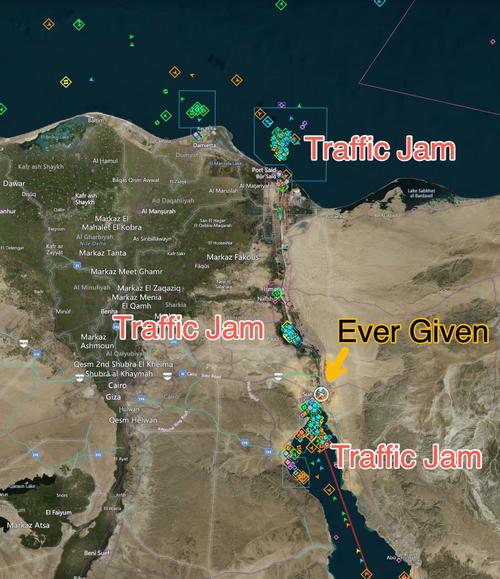Global Shippers Scramble To Reroute Ships Around Africa As Suez Crisis Worsens
As shipping companies grapple with the possibility that the Suez canal might be blocked to all traffic for a week or more, Maersk, the world’s biggest and most important shipping and supply-chain management company, is reportedly planning to divert ships around the southern tip of Africa.
Taking the long way around could add thousands of miles to some of the world’s most important shipping routes – those that carry goods and commodities from Asia to the West – which could force shippers to shoulder enormous additional costs – costs that must at some point be passed along to the end-consumer. To be sure, the company is also reportedly considering air routes as a potential for substitution, Bloomberg reports.
And Maersk isn’t alone: Hapag-Lloyd, the major German international shipper, is also considering rerouting ships around the Cape of Good Hope (the southern tip of the African Continent).
Earlier, the Maersk Denver, one of the ships stuck behind the “Ever Given” (the ship that’s stuck in the canal), managed to back out of the canal. It’s now back in the Red Sea.
Only other ship Maersk Denver behind EverGreen is also back in Red Sea. This means…
– Whenever freed EverGiven will be floated back to Red Sea
– The other ship either giving way or they realized it’s gonna be a long wait hence not worth to stay in the canal.#OOTT #Suez #Oil https://t.co/ra7C3fJJQ3 pic.twitter.com/tXcCAUUpLB
— Energy Blogger (@energy_blogger) March 25, 2021
Five Hapag-Lloyd ships have also been affected by the Suez Canal blockage.
In an emailed newsletter to employees, management advised “we are presently looking into possible vessel diversions around Cape of Good Hope.” As far as the Ever Given’s situation goes, the firm said it had no special insight into the situation, and must plan accordingly. “We don´t have any clear indication when the vessel will be refloated again,” the firm said, referring to the Ever Given, the container ship blocking the Suez Canal
The five Hapag-Lloyd ships affected are:
- Tsingtao Express, waiting in outer anchorage in Port Said
- Salahuddin, waiting in outer anchorage in Port Said
- Athenian, waiting in outer anchorage in Port Said
- Al Rawdah, scheduled to reach Suez Canal tonight
- New York Express, locked in at Great Bitter Lake
Meanwhile, the queue of ships waiting at the Suez Canal now stands at 237. Such a backlog could take days to clear on its own, even if the shipping lanes reopened immediately.
As exporters scramble to implement contingency plans, economists and market strategists are trying to suss out how this blockage might impact inflationary pressures, and market prices. While others are contemplating worst-case scenarios, as well as why the world wasn’t better prepared for something like this. After all, while there isn’t a known political dimension to this dispute, the Suez isn’t the only major chokepoint for global trade. In a note entitled “Central Banks Are Going To Need A Bigger Boat,” Rabobank’s Michael Every contemplates all this, and more.
“It seems an appropriate title today given one wonders who said that about the vessel still blocking the Suez Canal: was it trying to do a U-turn? If one ever wanted to imagine what blockading the Suez Canal looked like physically, and what it would deliver to already-strained global supply chains economically, well, enjoy. This obviously risks exacerbating the cost-push inflation pressures we are already seeing in many sectors. It may also briefly refocus analysts’ attention on just how vulnerable global trade is to blockages in key logistical bottlenecks, such as the South China Sea. Just imagine if it, or the Straits of Malacca, or the Straits of Hormuz were to be subject to geopolitical disruption. It’s a good job nobody is talking about any of these things ever happening, isn’t it?”
As Maersk and others order ships to re-route around Africa, the world will be watching to see how global supply chains are impacted.
Tyler Durden
Thu, 03/25/2021 – 11:37
via ZeroHedge News https://ift.tt/39gsdwV Tyler Durden
